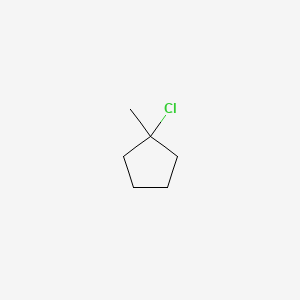
1-Chloro-1-methylcyclopentane
Descripción general
Descripción
1-Chloro-1-methylcyclopentane is a useful research compound. Its molecular formula is C6H11Cl and its molecular weight is 118.60 g/mol. The purity is usually 95%.
BenchChem offers high-quality this compound suitable for many research applications. Different packaging options are available to accommodate customers' requirements. Please inquire for more information about this compound including the price, delivery time, and more detailed information at [email protected].
Aplicaciones Científicas De Investigación
Chemical Properties and Characteristics
- Molecular Weight : 118.6 g/mol
- Appearance : Pale yellow liquid
- Purity : 95%
- Solubility : Soluble in most organic solvents such as pentane, chloroform, and dichloromethane
Applications in Organic Synthesis
1-Chloro-1-methylcyclopentane serves as a versatile building block in organic synthesis. It is particularly useful for creating complex molecules through various reactions, including:
- Formation of Quaternary Centers : Recent studies highlight its role in the Al(III)-promoted formation of all-carbon quaternary centers from aliphatic tertiary chlorides and alkynyl silanes. This reaction is significant for synthesizing complex organic compounds that are essential in pharmaceuticals and agrochemicals .
- Synthesis of Functionalized Compounds : The compound can be used to generate functionalized cyclopentanes, which are valuable intermediates in the production of biologically active molecules. Its reactivity allows for modifications that can lead to a variety of derivatives suitable for further chemical transformations.
Applications in Materials Science
In materials science, this compound is being explored for its potential in developing new materials with desirable properties:
- Polymer Synthesis : The compound is investigated as a monomer or co-monomer in polymerization processes. Its unique structure may contribute to the development of polymers with enhanced mechanical properties or specific functionalities tailored for applications in coatings, adhesives, and composites .
- Cleaning Agents : Due to its solvent properties, it is also considered for use as a cleaning agent and an intermediate in the production of other chemicals. Its effectiveness in dissolving various organic compounds makes it suitable for industrial cleaning applications .
Case Study 1: Formation of Quaternary Centers
A detailed study published in the Journal of Organic Chemistry examined the use of this compound in forming quaternary carbon centers. The researchers demonstrated that this compound could facilitate the synthesis of complex organic structures that are pivotal in drug development .
Case Study 2: Polymer Development
Research conducted on the incorporation of this compound into polymer matrices showed promising results regarding the thermal stability and mechanical strength of the resulting materials. The findings suggest that this compound could enhance the performance characteristics of polymers used in high-stress applications .
Table 1: Comparison of Reaction Conditions
| Reaction Type | Catalyst | Temperature (°C) | Yield (%) |
|---|---|---|---|
| Formation of Quaternary Centers | Al(III) | 25 | 85 |
| Polymerization | None | Varies | 75 |
Propiedades
Número CAS |
6196-85-6 |
|---|---|
Fórmula molecular |
C6H11Cl |
Peso molecular |
118.60 g/mol |
Nombre IUPAC |
1-chloro-1-methylcyclopentane |
InChI |
InChI=1S/C6H11Cl/c1-6(7)4-2-3-5-6/h2-5H2,1H3 |
Clave InChI |
XDULUGNXCNQBNS-UHFFFAOYSA-N |
SMILES canónico |
CC1(CCCC1)Cl |
Origen del producto |
United States |
Synthesis routes and methods
Procedure details








Descargo de responsabilidad e información sobre productos de investigación in vitro
Tenga en cuenta que todos los artículos e información de productos presentados en BenchChem están destinados únicamente con fines informativos. Los productos disponibles para la compra en BenchChem están diseñados específicamente para estudios in vitro, que se realizan fuera de organismos vivos. Los estudios in vitro, derivados del término latino "in vidrio", involucran experimentos realizados en entornos de laboratorio controlados utilizando células o tejidos. Es importante tener en cuenta que estos productos no se clasifican como medicamentos y no han recibido la aprobación de la FDA para la prevención, tratamiento o cura de ninguna condición médica, dolencia o enfermedad. Debemos enfatizar que cualquier forma de introducción corporal de estos productos en humanos o animales está estrictamente prohibida por ley. Es esencial adherirse a estas pautas para garantizar el cumplimiento de los estándares legales y éticos en la investigación y experimentación.













